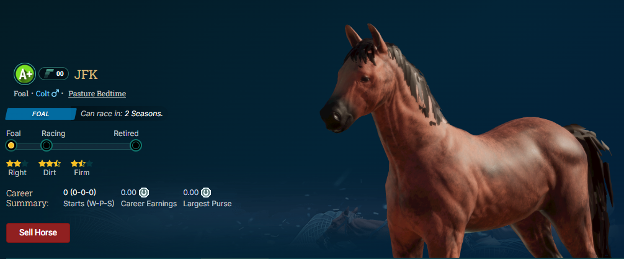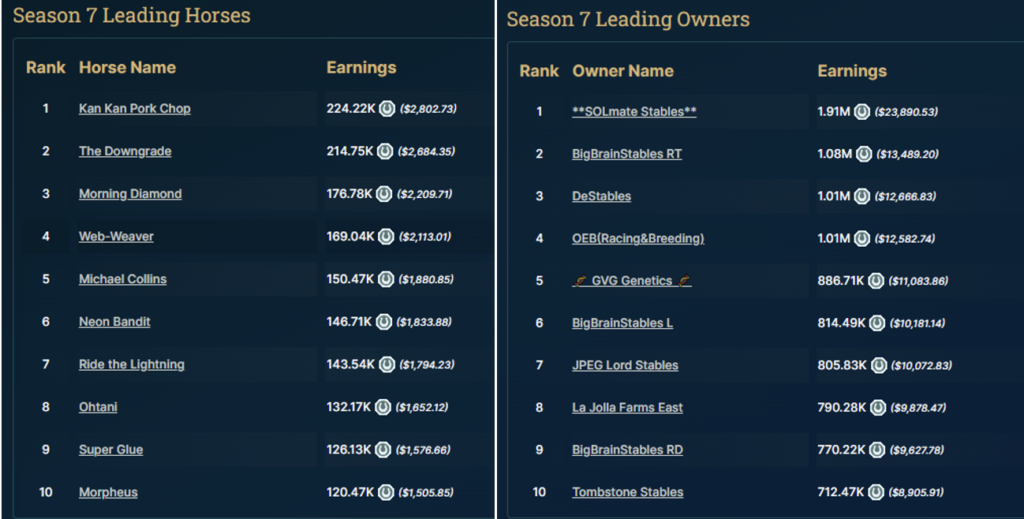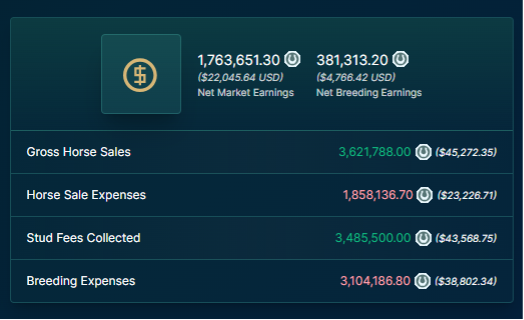My New Horse Could Be a Passive Income Machine
So, I went to see a man about a horse…
And I bought it.
A foal. Sired from a decent bloodline. Dad took the podium five times in 15 races. Mom was there twice in her three races.
I might be slightly worried about stamina, but based on his breeding this colt has heart and a good temper. Starts fast. Excellent speed, and loves a firm dirt track.
His name is JFK (I didn’t name him; nothing I can do about that). He’s part of my new stable of horses and he starts racing in December.
I mean, he’s a digital horse. That’s probably important to point out, too. Right?
If you’ve been a reader for a while, you’ll know I’m a big fan of non-fungible tokens, or NFTs, those one-of-a-kind cryptocurrency assets that take the form of digital art. You might also know that I am big fan of using NFTs and crypto to generate passive income.
Well, buying JFK was a combination of both. By the way, this is JFK:

My horse is part of a crypto-based horse-racing game called Photo Finish Live. The game is a deep dive into the economics of horse racing, breeding, stable management, even track ownership. (My stable is called Pasture Bedtime… such a great pun if I do say so myself!)
This is one of the more vibrant areas of crypto-based gaming, and it shows where we’re heading in terms of passive income and online entertainment. And, yes, there is potentially a sizeable passive income to earn here. I’ll show you an example of that in a moment, but there are stables that so far this year have earned a six-figure income.
To be clear, though, this isn’t a typical video game.
Horse races go off every few minutes, and they’re “televised” just as you would see the Kentucky Derby unfold in television.
The graphics are close to lifelike, though still clearly digital. There are different tracks around the world, including the famous Churchill Downs in Kentucky. In fact, the Kentucky Derby organization actually owns a track in Photo Finish Live, where it stages races for top-caliber digital horses, culminating in a digital version of the famous race, sans mint juleps.
Race results are a function of a horse’s characteristics/abilities, mixed with probability, and the other horses in the race.
And as with real life, horse owners pay real dollars to enter a race, and they compete for real purses. One example: The Red Sky Championship, run at Victoria Racecourse in Australia, requires an entry fee of 5,300 $DERBY to enter, with horses competing for prize money of 60,320 $DERBY. (Derby is the in-house token that’s always redeemable at 80 $DERBY per $1. So, the entry fee is equal to $66.25, with the purse equal to $754.)
After a race, a horse requires 20 hours of rest along with four hours of recovery, so you can basically race him once a day.
Each horse’s unique characteristics are a byproduct of breeding. JFK, for instance, comes from a father (a stud named Lawrence) and mother (Nana Neptunia) that both have strong characteristics for starting speed, track speed, finish speed and the like. The only potential weakness is that mom’s stamina is a B+ rating on a scale that runs from D- at the bottom to S+++ at the top. (S+++ is the “stud” level above A+. So, B+ isn’t horrible, but it could be problematic on longer runs; I’ll have to figure that out based on JFK’s racing results.)
None of this is random. All the data are based on races the parent horses ran in their career before moving into breeding, or, based on their internal characteristics if they ran no races before heading to pasture.
Each foal spends two years training before it’s allowed to race. In the game, a month equates to a year. They can race until they’re nine (which means nine months of racing in the real world), or stable owners can retire a horse at three and put into the breeding pool. Studs are paid a breeding fee, while broodmares get to keep the offspring and either race that horse or put it up for sale in the marketplace.
These digital horses will live for between 20 and 25 years (roughly two years in real-world game play), meaning stable owners have several months of racing to earn prize money, followed by a year or more of breeding/sales income. The set-up mimics real life and ensure a constant turnover of horses throughout the game’s lifespan.
The racing itself isn’t a matter of just sticking your horse in any ol’ race that’s open. It’s about strategy.
If JFK does have end up having stamina problems, then I’m not going to want to pay to race him in long-races of 10, 11, or 12 furlongs. I’ll want to focus on shorter and mid-length races or 4 to, maybe, 8 furlongs.
If he really is a lover of dirt tracks, I’ll probably not want to run him on turf.
And through his racing results, I’ll have to figure out if he likes firm tracks (sunny day racing) or if he’s a “mudder” who excels on soft tracks that come with rainy days. All this data—and much more—is available for each horse in the game, including all the bloodline data so that you, as a stable owner, can make educated decisions about the horses you buy, the studs and broodmares you use to breed with your horses, and the races you choose to enter.
Like I said, this is not your ordinary video game. This is a strategy game in which real prize money rests on your ability to manage a stable and chose the right horse for the right conditions.
And, yes, I do mean “real” prize money.
These are screen shots from the top stables in the game thus far into Season 7:

The first number is in $DERBY, so pay attention to the second number, which is in US dollars. The top horse has won more than $2,800 so far in season 7, which was about halfway done when I captured that screen shot. The top owner has won more than $23,000 so far this season.
And this is the lifetime data for one particular stable:

Up at the top, the first of numbers on the left, show that this stable has brought in more than $9,000 in winnings over seven seasons, as well as nearly $232,000 worth of $CROWN, another in-house currency with a different purpose that I won’t get into here.
Another stable, meanwhile, has brought in nearly $27,000 for breeding and selling horses:

Honestly, I am not sure what to expect from JFK. Will he earn his keep, or at least recoup the $292 I paid for him, plus whatever fees I pay to enter him into races? Will he breed well later on?
No idea on any of that.
But I gotta say, I’m excited to find out. And I’m excited to figure out JFK’s strengths and eventually manage a growing stable of horses (and passive income) I hope to build through my winnings.
JFK will start racing in a couple months. I’ll be sure to update you on what I hope will be his successes.
Before I sign off, I wanna note that after writing this column I bought another horse, a three-year-old already racing. I studied his statistics and realized his previous owner had been racing him in the wrong conditions. I paid $209.87 for him, registered him in a long race with a 0% chance of rain… and he won, earning me $97.89 in my first race and recouping nearly half of my investment.
Be warned: This game is addicting—and profitable.
Not signed up to Jeff’s Field Notes?
Sign up for FREE by entering your email in the box below and you’ll get his latest insights and analysis delivered direct to your inbox every day (you can unsubscribe at any time). Plus, when you sign up now, you’ll receive a FREE report and bonus video on how to get a second passport. Simply enter your email below to get started.
